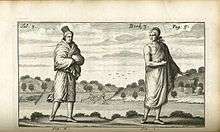Matchcoat

A matchcoat or match coat was a native american outer garment consisting of a length of coarse woolen cloth (stroud), usually about 2 metres (7 ft) long, worn wrapped around the upper part of the body like a toga.[2] The matchcoat might be worn by people either sex. It was a common article of trade by the English and French with the native peoples.
The matchcoat was usually fastened with a belt; no buttons or pins were used.[3]
A matchcoat might also serve as a blanket for sleeping.
The name "matchcoat" is a transliteration into English of an Algonquian word referring to clothing in general.[4]
History
The original of the matchcoat was a cloak of animal skin, often worn with the hair inside during colder weather. During the course of the 1600s this began to be replaced by woven material purchased from the European settlers.[3] In 1644 Johannes Megapolensis wrote
In winter, they [the Mohawks] hang about then simply an undressed deer or bear or panther skin; or they take some beaver and otter skins, wild cat, racoon, martin, otter, mink, squirrel or such like skins, of which there are plenty in this country, and sew some of them to others, until it is a square piece, and that is then a garment for them; or they buy of us Dutchmen two and a half ells of duffel, and that they hang simply about them, just as it was, without sewing it[5]
During the late 1600s there was increasing use of ready-made clothing and a corresponding decline in use of matchcoats.[3]
References
- ↑ Beverly, Robert (1705). The History and Present State of Virginia. Retrieved Oct 14, 2015.
- ↑ Hobbs, Davy. "Handbook For Native Interpreters". Fort Toulouse - Fort Jackson. Retrieved Oct 14, 2015.
- 1 2 3 Becker, Marshall Joseph. "Matchcoats: Cultural Conservatism and Change". Digital Commons@West Chester University. Retrieved Oct 14, 2015.
- ↑ Becker, Marshall (1982). "Excavations at the Prinzhof". Bulletin: Eastern States Archeological Federation (63). Retrieved October 14, 2015.
- ↑ Megapolensis, Johannes (1644). Account of the Mohawk Indians. Retrieved Oct 15, 2015.